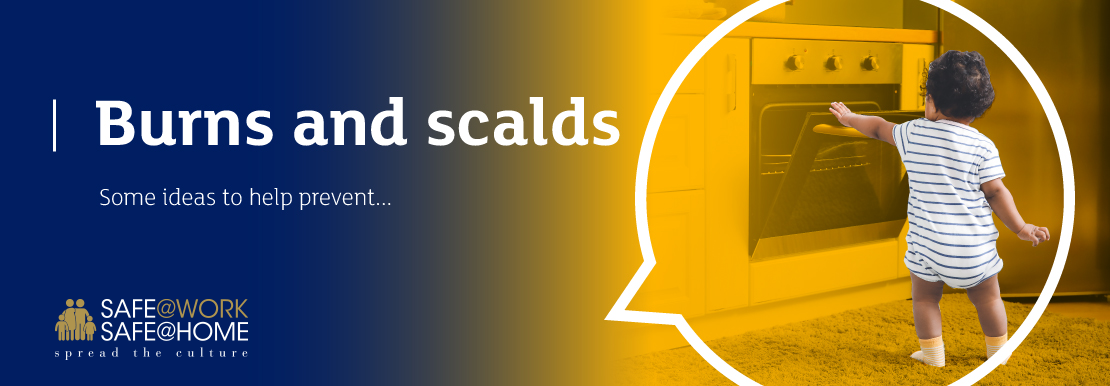
Burns and scalds
Burns and scalds are perhaps two of the most serious childhood injuries imaginable. Not only are they extremely painful, and occasionally life-threatening, they can cause scarring that lasts a lifetime.
Hospital admissions data for England indicate that there were around 2500 admissions for all burns and scalds injuries among children aged 0-4 alone . This represents over a third of all hospital admissions for scalds in England, a very high percentage. This is likely to be replicated in most countries as the 0-4 age group are particularly at risk from these types of injuries.
Children are particularly at risk from these, due to their natural inquisitiveness and because their skin is thinner than an adult’s, meaning they are more sensitive to high temperatures.
Fortunately, by taking some simple precautions, burns and scalds don’t have to happen.
Baths
Bathtime is an important part of most children’s routines. However, hot bath water is also responsible for the highest number of fatal and severe burn injuries among young children. The following tips can help keep your little ones safe:
Keep an eye on your child while the bath is running, not just once they’re in the bath. If you can keep the bathroom door closed to keep them out, even better
When filling a bath, run cold water first and then add hot water. Mix the water well to avoid hotspots
Only put your child in the bath when you’ve finished running it and checked the temperature. You’re more likely to feel if it’s too hot if you use your elbow
A thermostatic mixing valve (TMV) controls the temperature of water as it comes into the bath so that it’s hot enough to enjoy a good soak, but not hot enough to scald. If you don’t already have one, you might want to think about getting one fitted. Even with a TMV, however, water can still be hot enough to cause discomfort to a child’s delicate skin, so it is still important to follow the advice given above.
Bonfires and fireworks
“They think it's just a little burn and you get on with your life but you don't. Five years down the line we are still going for surgery…”
Fireworks can be great fun for families at celebrations such as Diwali, New Year’s Eve and Chinese New Year. Sadly, many people, including very young children, are badly hurt every year when things go wrong.
If you’re having a firework party at home there are steps you can take to make it safer:
Only adults should deal with setting up firework displays, the lighting of fireworks and the safe disposal of fireworks once they have been used
Children and young people should watch and enjoy fireworks from a safe distance
Direct any rocket fireworks well away from spectators
Never let children under five use a sparkler
Never hold a baby in your arms while you are holding a sparkler
When the sparkler has finished, put it in a bucket of cold water
Always supervise children around bonfires.
To find out more about bonfires, fireworks or sparklers, or to read the Fireworks Code in full, visit our fireworks page.
Fires and fireplaces
There’s nothing more comforting than the crackle of a log fire during the winter months. Even a portable or electric heater can help you keep cosy. However, if there are children around you need to take steps to make sure they are safe.
Supervision is important around fires
Keep all fires and heaters well-guarded, especially open fires, and ensure guards meet British Standards (BS)
For fitted or portable heaters with a built-in guard, give extra protection by adding a surrounding guard. For children, use a nursery guard with side clips that fit into fixed wall brackets.
Hot drinks
When you’re a busy parent, sometimes a hot cup of tea or coffee can be just the pick-up you need to get you through the day. Unfortunately, hot drinks and small children don’t mix. They are the number one cause of scalds to the under-fives. They can cause life-changing injuries and can still scald a child 15 minutes after being made
Never leave hot drinks within reach of children
Avoid drinking hot drinks while holding a baby or a child
Using a coiled lead on a kettle reduces the risk of a child pulling a kettle on top of themselves
If you use a hob, always use the back burners where possible, and turn pan handles in to stop children trying to grab them.
Other things to watch out for
There are many items in the home that can burn or scald. Here are some to be especially watchful for:
Hair straighteners can cause serious burns to children for up to 40 minutes after use. So, switch them off and store away immediately in a heat-resistant pouch
Mobile phone chargers can cause horrific burns if a child puts the live end in their mouth. Keep them switched off and out of the way when not in use
Oven doors, irons, hot pans – the kitchen is a dangerous place for small children. If you can, keep children out of the
kitchen while cooking
Candles – be especially careful if your child is in fancy dress, which can burn more easily than normal clothing. Be aware that homemade fancy dress costumes or those not tested to the same flammability standards may ignite easily and burn quicker
Always supervise children and pets if using lit candles
Do not allow children to carry, play, reach over, light or be near lit candles
Never leave a burning candle unattended
Remember always to extinguish a candle completely after use
Consider using battery operated candles instead
Children find flames fascinating, so matches and lighters are a serious risk. Keep them out of reach, preferably locked away. We recommend having one high, lockable cupboard in your kitchen to keep anything dangerous in one place and out of a child’s reach.